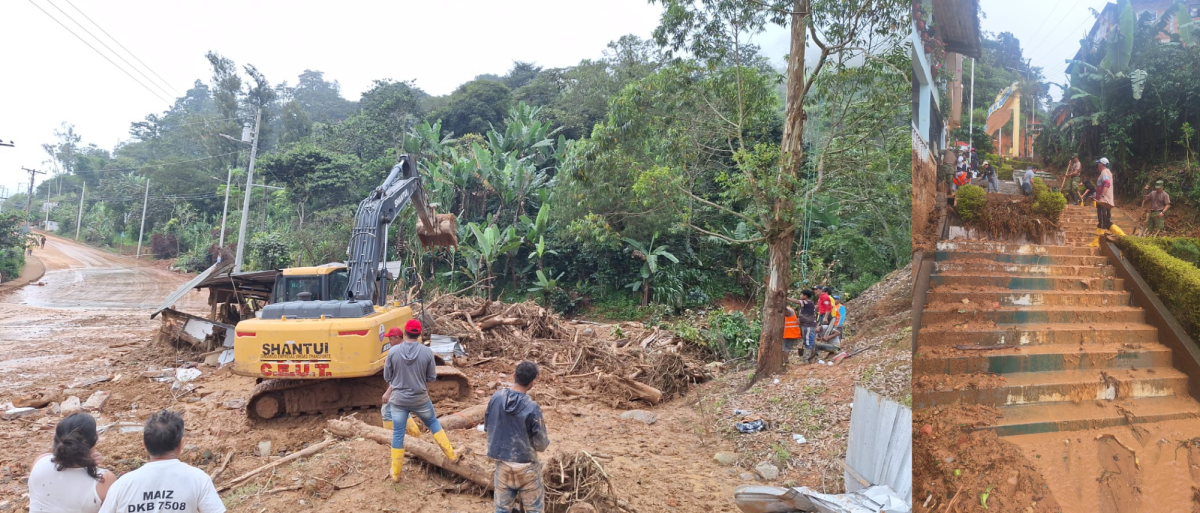Esta historia también esta disponible en Español aquí.
As the endless rain poured down and rivers overflowed their banks from the start of the new year through the first weeks of April, several provinces of Ecuador suffered an unprecedented torrential downpour that left devastation in its wake. Submerged homes and displaced families, this catastrophic event was not an isolated incident; Ecuador has experienced a worrying increase in flooding in recent years, aggravated by global warming, meteorological problems and El Niño—the climate phenomenon of warmer-than-average sea temperatures in the Pacific Ocean. Communities that once thrived now face recurring environmental threats as the government struggles to keep up with the growing challenges.
Digging deeper into the impact of the recent floods on the lives of over 140,000 Ecuadorians, the economic losses have also been of great concern during the response effort. The agricultural sector alone has faced 18,000 hectares of crops lost. In addition, the livestock sector had more than 50,480 animals affected and 62,000 dead animals. Additionally, a landslide ruptured the Trans-Ecuadorian Pipeline, spilling crude oil into rivers that were the main source of drinking water and irrigation for more than 300,00 people.
The National Institute of Meteorology and Hydrology (INAMHI) provides information about climate, water and weather through scientific publications in Ecuador. They have found that the intense rains are produced by the high humidity content, the concentration of wind in tropical zones, several intense tropical waves, climate change and the influence of global warming.
“In my opinion, climate change is increasing Ecuador’s vulnerability due to increased [torrential] rains that weaken natural ecosystems,” Carolina Puaquiza (12) said. “The lack of environmental policies has limited the country’s capacity to respond effectively to these disasters.”
From 1970 to the present, Ecuador has dealt with oppressive rains and intense floods during the winter months; these represent the largest number of reported hazards due to hydrometeorological causes. Thus, since January, over 2,000 cases of flooding have been reported due to heavy rainfall during the winter season. Among these events are landslides (39.92%), floods (39.83%), structural collapses (5.44%) and undermining (5.09%), which is when holes are formed under the ground by water erosion.
“The floods in Ecuador have caused severe losses in rural communities, made worse by [improper] human interaction with the environment,” Alisson Redrovan (12) said. “To support those affected, it is crucial to organize [fundraisers] to facilitate their recovery.”
The government, together with the National Secretariat of Risk Management (SNGR), activated an emergency plan that will last 60 days. This plan includes immediate assistance to hundreds of families that are or were affected by the destructive floods. In addition, provinces such as Guayas, Los Ríos, Manabí, El Oro, Esmeraldas, Santa Elena, Loja and Azuay will remain in a state of emergency for the same time. Besides, they have red, orange and yellow alerts, depending on the level of risk. The government has 28 active temporary shelters throughout the country where more than 254 people are currently living due to the loss of their homes. The SNGR was very active during these months, delivering close to 208,00 humanitarian assistance goods, including food kits, toiletries, mattresses and cleaning kits for the shelters.
Still, a tragic toll of nearly 50 deaths has accumulated. As the INAMHI warns about the continuation of these rains, the situation becomes even more delicate in several communities, with experts and citizens calling for the government to take precautions to protect still-standing homes and businesses. Despite the many challenges that have emerged, the Ecuadorian population is shining in its resilience through adversity. It is crucial to implement actions to reduce the factors that contribute to these climatic catastrophes and promote a better plan to solve these environmental issues in the country. Ecuadorian families can volunteer to clean up waste and residues from the floods, as well as donate food for people who lost their homes. The adaptive capacity and solidarity of Ecuadorians and the global community that supports them will be vital to overcoming this ongoing crisis and mitigating the impact of future events.








